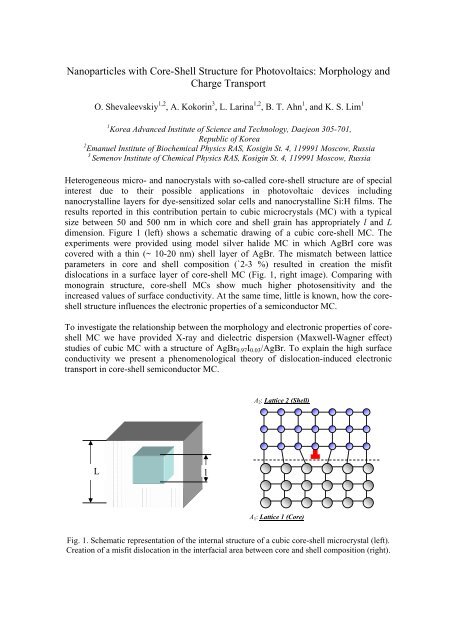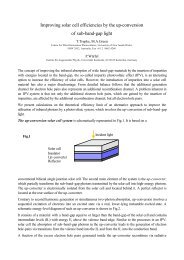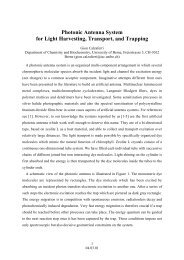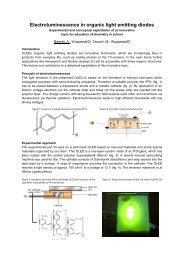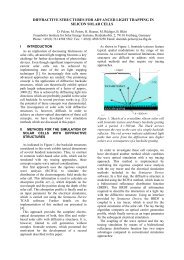Nanoparticles with Core-Shell Structure for ... - Quantsol.org
Nanoparticles with Core-Shell Structure for ... - Quantsol.org
Nanoparticles with Core-Shell Structure for ... - Quantsol.org
You also want an ePaper? Increase the reach of your titles
YUMPU automatically turns print PDFs into web optimized ePapers that Google loves.
<strong>Nanoparticles</strong> <strong>with</strong> <strong>Core</strong>-<strong>Shell</strong> <strong>Structure</strong> <strong>for</strong> Photovoltaics: Morphology and<br />
Charge Transport<br />
O. Shevaleevskiy 1,2 , A. Kokorin 3 , L. Larina 1,2 , B. T. Ahn 1 , and K. S. Lim 1<br />
1 Korea Advanced Institute of Science and Technology, Daejeon 305-701,<br />
Republic of Korea<br />
2 Emanuel Institute of Biochemical Physics RAS, Kosigin St. 4, 119991 Moscow, Russia<br />
3<br />
Semenov Institute of Chemical Physics RAS, Kosigin St. 4, 119991 Moscow, Russia<br />
Heterogeneous micro- and nanocrystals <strong>with</strong> so-called core-shell structure are of special<br />
interest due to their possible applications in photovoltaic devices including<br />
nanocrystalline layers <strong>for</strong> dye-sensitized solar cells and nanocrystalline Si:H films. The<br />
results reported in this contribution pertain to cubic microcrystals (MC) <strong>with</strong> a typical<br />
size between 50 and 500 nm in which core and shell grain has appropriately l and L<br />
dimension. Figure 1 (left) shows a schematic drawing of a cubic core-shell MC. The<br />
experiments were provided using model silver halide MC in which AgBrI core was<br />
covered <strong>with</strong> a thin (~ 10-20 nm) shell layer of AgBr. The mismatch between lattice<br />
parameters in core and shell composition (`2-3 %) resulted in creation the misfit<br />
dislocations in a surface layer of core-shell MC (Fig. 1, right image). Comparing <strong>with</strong><br />
monograin structure, core-shell MCs show much higher photosensitivity and the<br />
increased values of surface conductivity. At the same time, little is known, how the coreshell<br />
structure influences the electronic properties of a semiconductor MC.<br />
To investigate the relationship between the morphology and electronic properties of coreshell<br />
MC we have provided X-ray and dielectric dispersion (Maxwell-Wagner effect)<br />
studies of cubic MC <strong>with</strong> a structure of AgBr 0.97 I 0.03 /AgBr. To explain the high surface<br />
conductivity we present a phenomenological theory of dislocation-induced electronic<br />
transport in core-shell semiconductor MC.<br />
A 2 : Lattice 2 (<strong>Shell</strong>)<br />
L<br />
l<br />
A 1 : Lattice 1 (<strong>Core</strong>)<br />
Fig. 1. Schematic representation of the internal structure of a cubic core-shell microcrystal (left).<br />
Creation of a misfit dislocation in the interfacial area between core and shell composition (right).
The X-ray powder diffraction data were obtained by using a RIGAKU D/MAX-B X-ray<br />
diffractometer. Figure 2 demonstrates a remarkable difference between X-ray diffraction<br />
intensities obtained <strong>for</strong> core-shell structure (a) and <strong>for</strong> a mixture of the appropriate<br />
monograin MCs (b). To calculate the relative intensities of X-ray diffraction patters in a<br />
core-shell structure we have provided the theoretical simulation and obtained the<br />
appropriate <strong>for</strong>mulas <strong>for</strong> different MC compositions. Figure 3 (c) presents the results of<br />
the theoretical simulation together <strong>with</strong> the experimental results obtained <strong>for</strong><br />
AgBr 0.97 I 0.03 /AgBr MCs.<br />
(a)<br />
I 1 /I 2 , (a. u.)<br />
(c)<br />
(b)<br />
(L – l)/L<br />
)<br />
Fig. 2. X-ray diffraction patterns <strong>for</strong> AgBr 0.97 I 0.03 /AgBr core-shell MC (a) and a mixture of mono<br />
grain MCs <strong>with</strong> the same structure. Theoretical simulation of the relative X-ray intensitited in a<br />
core-shell MCs (c).<br />
Figure 3 shows the experimental curve <strong>for</strong> dielectric losses in core-shell microcrystals<br />
imbedded in a dielectric media. The calculation revealed that the value of dark<br />
conductivity in a surface subsystem (shell) is 2 orders of magnitude higher, than the one<br />
in the bulk (core).<br />
ε''/ε''max<br />
1.0<br />
0.8<br />
0.6<br />
0.4<br />
AgBrI<br />
AgBr<br />
Fig. 3. Experimental results <strong>for</strong><br />
normalized imaginary part of<br />
dielectric permittivity <strong>for</strong> core-shell<br />
AfgBrI/AgBr MC, embedded in a<br />
dielectric media (points) and<br />
theoretical simulation of the<br />
appropriate contributions from the<br />
core and the shell subsystems.<br />
3 4 5 6 7 8<br />
log f


